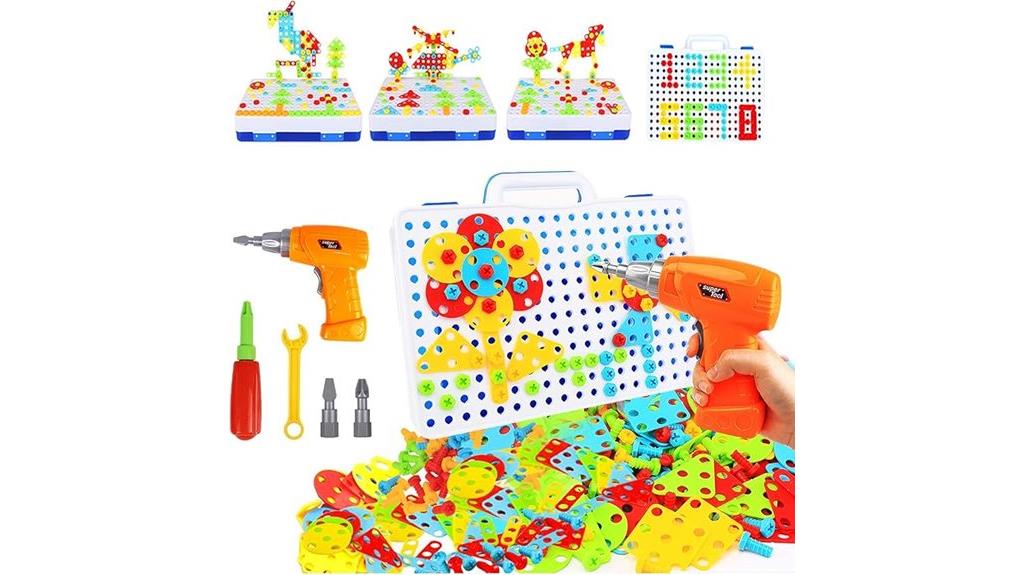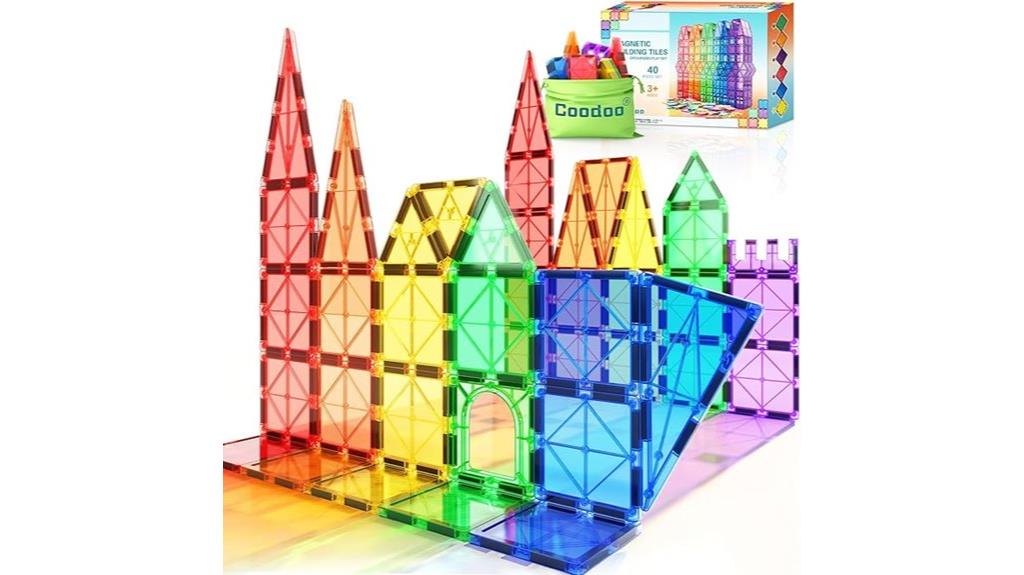If you’re looking for the best STEM toys for toddlers in 2025 that promote learning and fun, I recommend a mix of building kits, light-up blocks, and dinosaur sets designed for young minds. These toys encourage creativity, fine motor skills, and problem-solving while ensuring safety with non-toxic materials. Curious about which options will truly spark your child’s passion for STEM? Keep exploring to discover all the top choices that can grow with your little one.
Key Takeaways
- Building sets like HAPTIME and design kits develop creativity, spatial skills, and problem-solving for ages 3-8.
- Safety standards ensure non-toxic, BPA-free, rounded-edge toys suitable for toddlers and preschoolers.
- Bright, contrasting colors and sensory features enhance visual development and engagement during play.
- Age-appropriate complexity supports cognitive growth, from simple blocks for toddlers to advanced gear sets for older children.
- Toys promote fine motor skills, reasoning, and independent exploration through hands-on, open-ended STEM activities.
HAPTIME STEM Toys for Kids Aged 3-8, Electric Drill and Building Kit

If you’re looking for a STEM toy that keeps kids engaged and encourages hands-on learning, the HAPTIME Electric Drill and Building Kit is an excellent choice for children aged 3 to 8. This set includes 193 pieces, allowing kids to build 2D and 3D models like lions, trucks, and butterflies. The interactive nature promotes creativity, reasoning, and spatial skills while making learning fun. With interchangeable drill bits, a rechargeable drill, and a sturdy storage case, it’s perfect for active, curious kids. Plus, it’s made from safe, BPA-free plastic, ensuring safe play during all those hours of exploration.
Best For: parents and educators seeking an engaging, educational STEM toy that promotes creativity and hands-on learning for children aged 3 to 8.
Pros:
- Encourages creativity, reasoning, and spatial skills through diverse building projects
- Made from safe, BPA-free, non-toxic plastic with rounded corners for secure play
- Comes with a rechargeable drill, numerous accessories, and a large storage case for convenience
Cons:
- Requires 2 AA batteries (not included) for the electric drill
- May be challenging for very young children under 3 due to small parts
- The complexity of patterns might be overwhelming for some younger children without adult assistance
HAPTIME STEM Toys for Kids Aged 3-8, Design & Drill Set, 193 Pcs Educational Building Toy

HAPTIME STEM Toys for kids aged 3-8 stand out with their extensive 193-piece electric drill building set, making them an excellent choice for children who love hands-on, creative activities. Kids can build 2D and 3D models like lions, trucks, and butterflies by assembling plates onto a base grid. The set encourages independent exploration, fostering creativity, spatial reasoning, and STEM skills. It includes interchangeable drill bits, a rechargeable drill, nuts, bolts, tools, and a storage case for easy cleanup. Made from BPA-free, durable plastic, it’s designed for safe, engaging play, perfect for young builders enthusiastic to learn and create.
Best For: children aged 3-8 who enjoy hands-on building activities, STEM learning, and creative play.
Pros:
- Promotes cognitive development, creativity, and STEM skills through engaging building projects.
- Includes a variety of accessories and interchangeable drill bits for versatile play.
- Made from safe, BPA-free, durable materials suitable for young children.
Cons:
- Requires 2 AA batteries (not included) for the electric drill.
- Some small parts may pose a choking hazard for very young children without supervision.
- Assembly instructions may be challenging for very young users without adult help.
Building Block Sets for Kids 3-6 Years Old

Building Block Sets for Kids 3-6 Years Old are an excellent choice for parents and educators seeking engaging STEM toys that promote creativity and problem-solving. These sets include 30 colorful, translucent blocks in various shapes and sizes, perfect for preschoolers. The included guidebook offers over 60 designs, encouraging children to explore engineering concepts and expand their imaginations. Compatible with light tables, the blocks glow, creating mesmerizing sensory effects. Made from high-quality, non-toxic materials, they’re safe and durable for active play. Open-ended and versatile, this set helps develop spatial awareness, fine motor skills, and critical thinking—all while making learning fun.
Best For: parents, teachers, and caregivers seeking engaging, safe, and educational STEM building toys for children aged 3-6 to foster creativity, problem-solving, and sensory development.
Pros:
- Encourages STEM learning through problem-solving, spatial awareness, and fine motor skill development.
- Made from high-quality, non-toxic, durable materials ensuring safety and long-lasting play.
- Features translucent, glow-in-the-dark blocks that create captivating visual and sensory effects on light tables.
Cons:
- Limited to 30 pieces, which may be less suitable for extended or more complex building projects.
- Requires a light table for the glowing effect, potentially adding extra cost or setup.
- May be less challenging for children who quickly master basic stacking and building activities.
Dinosaur STEM Toys for Kids 3-8 Years Old

Dinosaur STEM toys for kids aged 3-8 are an excellent choice for young explorers who love dinosaurs and hands-on learning. This 3-pack set includes a green Triceratops, blue T-Rex, and brown Velociraptor, each with realistic colors that spark creativity. Kids can assemble these dinosaurs using a low-speed electric drill, manual screwdrivers, and clear instructions, promoting fine motor skills and STEM skills. Movable joints let children pose their dinosaurs, encouraging imaginative play. Made from durable, non-toxic materials, these toys are safe and easy to handle. They’re perfect for birthdays or holidays, inspiring curiosity and learning through engaging building activities.
Best For: young children aged 3-8 who are interested in dinosaurs, STEM learning, and hands-on building activities.
Pros:
- Encourages creativity, imagination, and fine motor skills through assembly and posing.
- Includes realistic, colorful dinosaur models that attract children’s attention.
- Made of durable, non-toxic materials ensuring safety during play and assembly.
Cons:
- Requires adult supervision for proper assembly and safety precautions.
- May be challenging for very young children to use the electric drill without assistance.
- Limited to three dinosaur models, which might not satisfy more advanced dinosaur enthusiasts.
Coodoo Magnetic Tiles Kids Toys (40PCS)

If you’re looking for a STEM toy that sparks creativity and supports developmental growth in young children, the Coodoo Magnetic Tiles Kids Toys (40PCS) is an excellent choice. This set includes 40 colorful magnetic tiles in various shapes, perfect for small hands to grasp and build. The tiles are compatible with other brands, so expanding your collection is easy. They promote open-ended play, helping children develop problem-solving skills, pattern recognition, and an understanding of magnetic principles. Made from food-grade ABS plastic with rounded edges, they’re safe and durable for everyday use. Plus, the portable carrying bag makes it ideal for on-the-go learning and play.
Best For: young children, preschoolers, and early learners who enjoy creative, STEM-based, and sensory play experiences.
Pros:
- Promotes creativity, problem-solving, and STEM skills through open-ended building fun.
- Made from safe, food-grade ABS plastic with rounded edges for durability and safety.
- Compatible with other brands, allowing easy expansion and larger constructions.
Cons:
- Limited to 40 pieces, which may restrict larger or more complex projects for advanced builders.
- Requires supervision for very young children to avoid potential swallowing hazards despite safety features.
- Not suitable for children who prefer electronic or digital toys over physical building sets.
Factors to Consider When Choosing STEM Toys for Toddlers

When selecting STEM toys for toddlers, I focus on safety standards and age-appropriate complexity to make certain they’re both safe and beneficial. I also look for non-toxic materials and vibrant visuals that keep my child’s attention. Ultimately, I choose toys that support skill development while being engaging and suitable for their developmental stage.
Safety Standards Compliance
Choosing the right STEM toys for toddlers means paying close attention to safety standards to guarantee their well-being. I always check if a toy meets certifications like ASTM F963, EN71, or CPSIA, which ensure it adheres to strict safety guidelines. It’s essential that the materials are non-toxic, BPA-free, and free from harmful chemicals to prevent health risks during play. I also look for toys with rounded edges and smooth surfaces to reduce the risk of cuts or scratches. Small parts should be appropriately sized, especially for children under three, to avoid choking hazards. Additionally, I seek out toys with independent testing labels and positive reviews, confirming they meet high safety and quality standards. Prioritizing these factors helps keep playtime both fun and safe.
Age-Appropriate Complexity
Selecting STEM toys that match a toddler’s developmental stage guarantees they can enjoy and benefit from play without feeling overwhelmed. For ages 1-3, choose toys with large, simple pieces that promote basic problem-solving and fine motor skills. These toys should be easy to manipulate and safe for little hands. For ages 3-6, opt for slightly more complex options like magnetic tiles or simple assembly kits that challenge reasoning without causing frustration. As children approach 6-8, select toys featuring gears, robotics, or detailed models that align with their growing cognitive abilities. Always check age recommendations and safety warnings on the packaging. Matching the toy’s complexity to their developmental stage ensures engaging, safe, and meaningful learning experiences.
Material Non-Toxicity
Ensuring that STEM toys for toddlers are made from non-toxic materials is essential for their safety, especially since young children often mouth objects during play. Using food-grade ABS plastic is common because it’s safe, durable, and non-toxic. Look for toys with BPA-free, phthalate-free, and lead-free certifications—these indicate the absence of harmful chemicals. Independent safety testing also helps verify that materials meet health standards for young kids. Choosing non-toxic toys reduces the risk of allergic reactions and chemical exposure, ensuring a safer play environment. When shopping, always check labels and certifications to confirm the materials are safe. Prioritizing non-toxic materials gives peace of mind and protects your child’s health while they explore and learn through play.
Engaging Visuals and Colors
Bright, vibrant colors in STEM toys instantly capture toddlers’ attention and enhance their visual development. These bold hues help children differentiate shapes and improve their color recognition skills through contrast. Using contrasting colors makes it easier for little ones to identify and sort objects, fostering early cognitive skills. Multicolored components also encourage curiosity and exploration, making playtime more engaging and dynamic. Colorful visuals inspire creativity, motivating children to build, design, and imagine new structures. Incorporating a variety of colors supports pattern recognition and sorting, essential for cognitive growth in toddlers. When choosing STEM toys, opt for those with lively, contrasting, and diverse colors to stimulate visual senses and promote active, playful learning. Bright visuals truly make STEM play both fun and educational.
Skill Development Focus
When choosing STEM toys for toddlers, it’s important to focus on how well they support specific skill development, such as fine motor control, spatial reasoning, or problem-solving. I look for toys that target these areas directly, helping children build a strong foundation. Toys with adjustable complexity are ideal because they can grow with the child, offering just the right challenge at each stage. I also prefer options that combine multiple skills, like building, sorting, or pattern recognition, to promote well-rounded growth. Ensuring the toys are made from safe, non-toxic materials is essential, especially for tactile exploration. Finally, I choose toys that encourage independent play and critical thinking, fostering confidence, creativity, and a love for learning through active engagement.
Ease of Assembly
Choosing STEM toys that are easy to assemble is essential because toddlers are still developing their fine motor skills. I look for toys with large, chunky pieces that are simple to grasp and connect without complex instructions. Toys designed for minimal tools or steps make assembly less frustrating and encourage independence. Clear, visual step-by-step instructions help young children understand how to put pieces together confidently. I also prioritize toys with secure, snap-together components that stay together during active play, preventing unnecessary frustration. Safety features like rounded edges and non-toxic materials are equally important, ensuring the assembly process is safe and stress-free. When a toy is straightforward to assemble, it boosts a child’s confidence and keeps them engaged in hands-on learning.
Portability and Storage
After ensuring that STEM toys are simple to assemble, I also focus on how easy they are to carry and store. I look for toys that come with a portable carrying case or bag, making transportation and cleanup straightforward for toddlers. Compact designs with fewer small parts help prevent loss and assure safe handling during travel or storage. Toys with built-in compartments or organizers keep all components neatly contained and accessible, reducing clutter. I prioritize lightweight, durable materials that can withstand frequent movement and outdoor use without damage. Additionally, I choose toys that are easy to pack away or expand, offering flexible storage options in small spaces or on-the-go. These features make the toys more practical and enjoyable for active toddlers.
Educational Content Quality
High-quality educational content is essential because it guarantees that STEM toys deliver accurate, age-appropriate information that genuinely promotes learning. When the content is well-designed, it encourages kids to think critically, solve problems, and explore creatively, rather than just passively playing. Clear instructions and engaging patterns help children grasp concepts more easily, building a strong foundation in STEM skills. I also look for toys with content that is regularly updated to reflect current scientific knowledge and educational standards, ensuring relevance as kids grow. Plus, safety matters—materials should be non-toxic and secure so that children can learn in a safe environment. Ultimately, high-quality content makes a meaningful difference in fostering curiosity, understanding, and a love for STEM from a young age.
Frequently Asked Questions
How Do STEM Toys Benefit Toddlers’ Early Development Skills?
STEM toys benefit toddlers’ early development skills by encouraging curiosity and problem-solving. I’ve seen how they help children develop fine motor skills, critical thinking, and creativity through hands-on play. These toys foster a love for learning while building foundational skills in science, technology, engineering, and math. When kids explore and experiment with STEM toys, they become more confident, engaged, and enthusiastic to discover new ideas.
Are STEM Toys Safe for All Toddler Age Groups?
Absolutely, STEM toys are safe for most toddler age groups when chosen carefully. I’ve seen these toys turn ordinary playtime into a magical learning adventure—like a tiny scientist’s dream! Just make certain they’re age-appropriate, free of small parts, and made from non-toxic materials. Always supervise your little one during play, and you’ll both enjoy exploring new skills safely and happily.
What Is the Recommended Age Range for Different STEM Toys?
The recommended age range for STEM toys varies, but generally, toddlers aged 1 to 3 years benefit from simple, large-piece toys that promote basic problem-solving and motor skills. For children aged 3 to 5, I suggest more complex, interactive toys that encourage critical thinking and creativity. Always check the manufacturer’s guidelines to guarantee the toy aligns with your child’s age and developmental stage for safe and engaging play.
How Can Parents Encourage STEM Learning Through These Toys?
Think of STEM toys as a gateway to a child’s curiosity. I encourage parents to get hands-on, ask open-ended questions, and explore together. By showing genuine interest and guiding play, you turn simple toys into adventures of discovery. Let your child’s imagination run wild, and celebrate every discovery. This active involvement sparks a love for learning and builds a strong foundation for future STEM exploration.
Do STEM Toys Support Both Individual and Collaborative Play?
Yes, STEM toys support both individual and collaborative play. I find that many toys encourage kids to explore on their own, solving puzzles or building structures independently, which boosts confidence and problem-solving skills. At the same time, these toys often promote teamwork, where children work together to create or figure out challenges. This balance helps develop social skills and fosters a love for learning in different settings.
Conclusion
Did you know that 92% of parents believe STEM toys boost their child’s problem-solving skills? With so many options out there, choosing the right one can feel overwhelming. But remember, the best toys are those that spark curiosity and encourage hands-on learning. Whether it’s building with blocks or exploring magnets, these toys can set your toddler on an exciting STEM journey. Start today, and watch their young minds grow!









